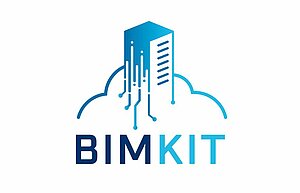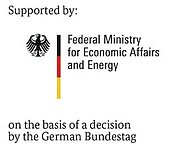
BIMKIT
As-built modeling of buildings and infrastructure using AI to generate digital twins
Duration: January 2021 – December 2023
Funded by BMWi in the second call for projects „Innovation Contest Artificial Intelligence“
Challenges and objectives
Building Information Modeling (BIM) stands for the use of 3D models in the life cycle of a building. Most BIM applications require a digital inventory model as a basis, e.g. for optimizing maintenance, renewing infrastructures or demolishing buildings. In addition, digitally available information on a building enables efficient and sustainable operation. Despite all the advantages of digital planning, construction and operation, 3D models are not available, especially for existing buildings. This not only delays the introduction of BIM, but also lacks reliable data for the entire construction and housing industry to optimize the life cycle of a building.
BIMKIT starts here, with the aim of making AI and cloud technologies usable for the construction industry as key technologies in the federal government's digitization strategy. Information on buildings and infrastructure structures, e.g. 2D plans, images, point clouds or text documents, should be evaluated using AI processes, structural and technical components should be generated and fed consistently and transparently to a BIM-based as-built model. The updating of an existing model should also be automated. The data and AI services are provided decentrally with the help of open standards and existing BIM systems based on GAIA-X. Data sovereignty and data security are particularly taken into account, since security-relevant information on buildings is also evaluated. An ecosystem is created, which forms a fundamental basis for BIM applications.
Contribution by Fraunhofer HHI
Fraunhofer HHI is involved in BIMKIT with all four research groups in its “Vision and Imaging Technologies” department. The focus of this work will be the development of AI processes for the existing modeling of buildings and infrastructure as well as for noise protection planning. The aim is to develop AI methods for the automated generation of digital twins of real buildings, which are made available to BIM applications in planning, construction and operating processes. Furthermore, the development of concepts for the plausibility check of the AI results and the generated BIM models is mainly worked on by researchers at Fraunhofer HHI.
Project consortium
- Hottgenroth Software GmbH & Co. KG (project coordination)
- AI4BD Deutschland GmbH
- ALLPLAN GmbH
- A+S Consult GmbH
- eTASK Immobilien Software GmbH
- Fraunhofer Gesellschaft für Angewandte Forschung e.V. - Heinrich-Hertz-Institut (HHI)
- Hexagon Geosystems Services AG
- Neue Technologien AG
- planen bauen 4.0 GmbH
- Ruhr-Universität Bochum, Lehrstuhl Informatik im Bauwesen
- Schüßler-Plan Ingenieurgesellschaft mbH
Associated partners
- Bauakademie
- Bundesanstalt für Immobilienaufgaben (BImA)
- Bundesarchitektenkammer (BAK)
- Bundesingenieurkammer (BIngK)
- Bundesindustrieverband Technische Gebäudeausrüstung (BTGA)
- Bundesverband Bausoftware (BVBS)
- Bundesverband deutscher Wohnungs- und Immobilienunternehmen (GDW)
- Bundesvereinigung Mittelständischer Bauunternehmen (BVMB)
- DB Netz AG
- DEUBIM GmbH
- Deutscher Verband für Facility Management (GEFMA)
- Fachverband Baustoffe und Bauteile für vorgehängte hinterlüftete Fassade ((FVHF)
- Hauptverband der deutschen Bauindustrie (HDB)
- Ingenieurbüro Dr.-Ing. R. König
- Kapellmann und Partner Rechtsanwälte mbH
- Landesamt für Straßenbau und Verkehr Sachsen (LaSuV)
- ProSiebenSat.1Media
- TU-Berlin, Fachgebiet Digitale Architektur und Nachhaltigkeit
- Verband Beratender Ingenieure (VBI)
- VIA IMC GmbH
- virtual city systems (VCS)
- Zentrum für Angewandte Forschung und Technologie, HTW Dresden
- Zentralverband Sanitär, Heizung, Klima (ZVSHK)
